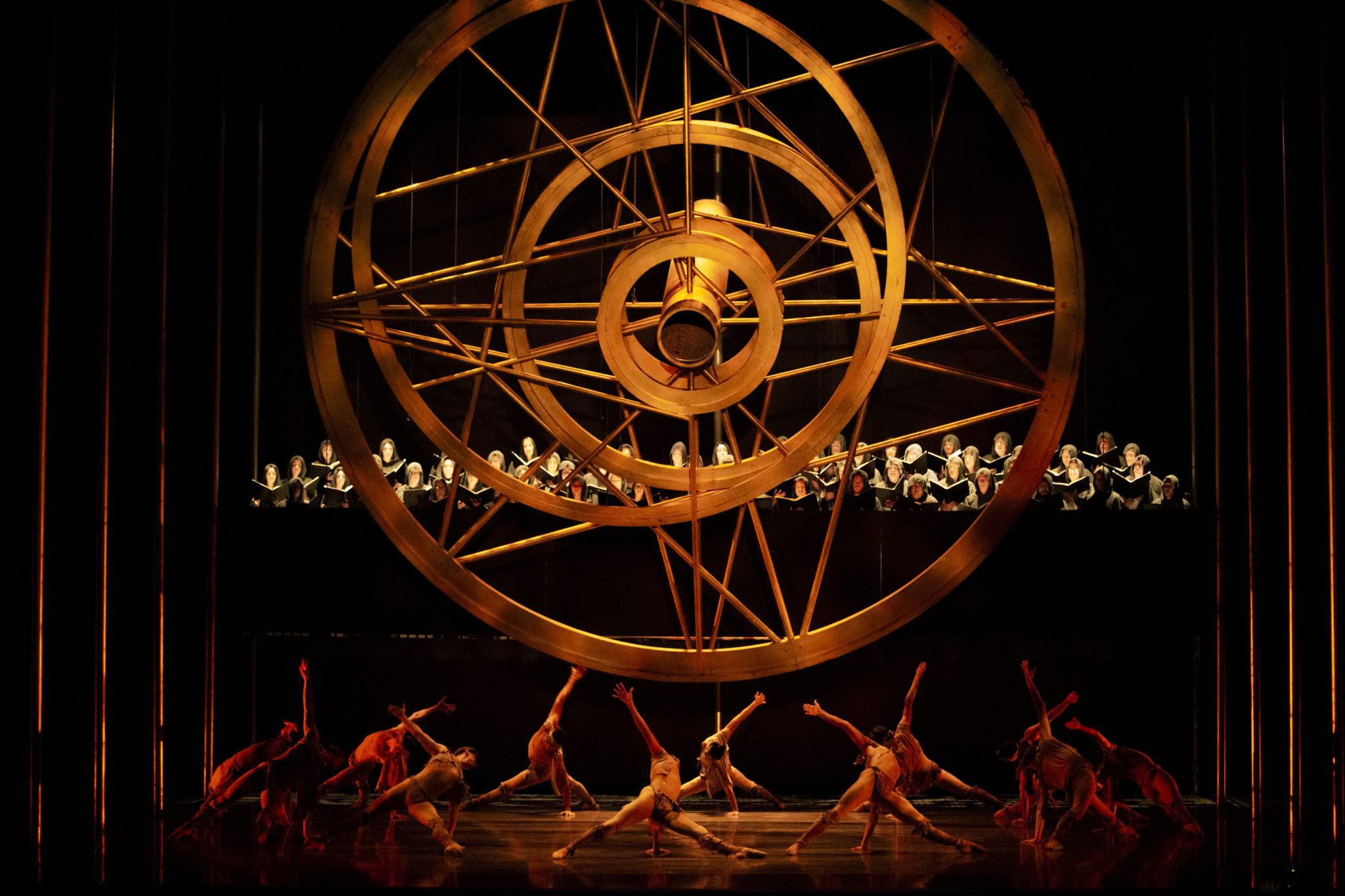
Pacific Northwest Ballet is starting the season with a powerful pair of 20th century ballets: George Balanchine’s Agon and Kent Stowell’s Carmina Burana. In many ways, Agon is the better ballet, but Carmina Burana is the audience favorite. It’s only natural – Carmina Burana is an irresistible combination of passion and spectacle.
Starting with a Bang
Discussions of quality in art are fraught, and any conclusions are suspect. Does better mean more technical? More beautiful? More appropriate to the creator’s thematic intent? Even so, I feel pretty confident saying that Carmina Burana has the best opening of any ballet, ever. The curtain rises to a stage filled with prostrate bodies, and elevated above them, seventy choristers sing this:
Above them spins a 26-foot wide, 2500-pound golden wheel of fortune. Even the dead would get chills.
Carmina in Context
In 1803, in the library of the Bavarian monastery of Benediktbeuren, someone discovered a collection of thirteenth-century goliard poetry – basically, dirty songs. In 1937, composer Carl Orff set a selection of the best of these poems to music with a score so powerful and primal that it has been called the peer of Stravinsky’s Rite of Spring. I would argue that the two pieces of music are equally powerful, but my money is Orff for most primal. Stravinsky always requires some brain to be appreciated but Carmina Burana reaches in your ears and wraps itself around your brain stem. It’s the stuff of wars and orgies.
According to the program booklet, Orff dreamed of “total theater” which would
…cut across social, educational, and temporal boundaries to engage audiences in a powerful communal experience.
In 1993, then-PNB Artistic Director Kent Stowell choreographed the ballet to match the music. He worked with company artists Ming Cho Lee for scenic design, Larae Hascall for costumes, Randall Chiarelli for lights, and pulled in the Pacific Lutheran University Choral Union to create a completely home-grown production that is almost more operatic than balletic. I think Carmina Burana comes as close to Orff’s total theater as it’s possible to do in the context of a Judeo-Christian world view.
Sandwiches and Book Ends
“O Fortuna” is the opening song. It’s downhill from there, really, but when the peak is that high, even the descent is thrilling. After the big bang, the dancers rise from the floor and that first piece is ballet veering incredibly close to ecstatic dance. The final piece returns to the theme of “O Fortuna,” completing the turn of the wheel and ending as spectacularly as it began.
Bookended by such high drama, most people (me) tend to forget about the tamer, more conventional parts in the middle. Like every ballet ever, peasants do some folk dances in “Primo Vere.” There are some courtly dances, too, in “Cour D’Amour.” Dance-wise, there’s not much to differentiate these sections from dozens of others like them. But production-wise, several factors – like the giant wheel overhead and the interaction between singers and dancers – make them more interesting.
Among the paired-off peasants and courtiers there are couples in flesh-colored bodysuits. These pseudo-nudes sometimes serve to remind us what the other couples are about to get up to. But especially in “Cour D’Amour,” one couple (I saw Lesley Rausch and Jerome Tisserand) evoke pre-Fall Adam and Eve more than randy randos. I’m not a big fan of divine grace, so let’s call them a reminder that human love can also be transcendent.
Sandwiched between these two pieces is “In Taberna.” More in the “O Fortuna” vein this one is filled with temptation and suffering. It includes a charged tenor aria (Zach Finkelstein) that will put the fear of god into you even if the heavy visual references to Prodigal Son don’t. Throughout the ballet, vocalists in religious costume who perform solo arias while interacting, in character, with the dancers on the stage. A last-minute substitution, soprano Maria Mannisto performed beautifully. Baritone Keith Harris has one of the most memorable moments in the ballet, when the harlot (Noelani Pantastico) slides between his legs and he crosses himself.
A Word on Words
I would have liked to have supertitles or have the lyrics printed in the book so that I could follow along, but the ballet is sufficiently expressive that you don’t really need them. Although their origin is monastic and their worldview Christian, these are poems that speak to fundamental human passions. It’s an audience favorite because we’ve all been there.
Carmina Burana
Music: Carl Orff
Choreography: Kent Stowell
Scenic Design: Ming Cho Lee
Costume Design: Theoni V. Aldredge and Larae Theige Hascall
Lighting Design: Randall G. Chiarelli
Running Time: 70 minutes
Premiere: October 5, 1993; Pacific Northwest Ballet
Remaining Performances
October 3, 4 & 5 at 7:30 PM
October 6 at 1:00 PM
Tickets start at $37 and are available through the PNB Box Office at 206.441.2424, in person at 301 Mercer Street, or online.

Cast I Saw
Carmina Burana
Soprano
Maria Mannisto or Christina Siemens
Tenor
Zach Finkelstein
Baritone
Keith Harris
Fortuna Imperatrix Mundi
Angelica Generosa*
Dylan Wald
Margaret Mullin
Steven Loch
Elle Macy*
Joshua Grant*
Primo Vere
Leta Biasucci
Benjamin Griffiths
In Taberna
James Moore*
Seth Orza*
Noelani Pantastico*
William Lin-Yee*
Cour D’Amour
Lesley Rausch
Jerome Tisserand
{I attended Carmina Burana/Agon courtesy of Pacific Northwest Ballet. The tickets were theirs; the opinions are mine.}




About the author